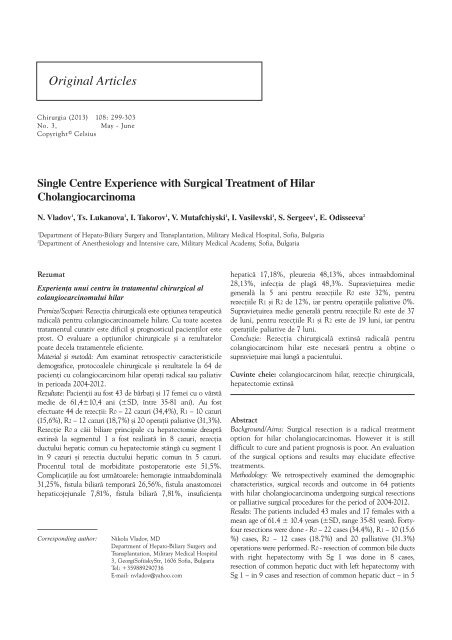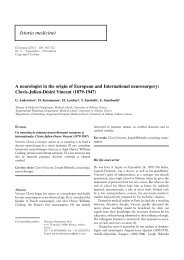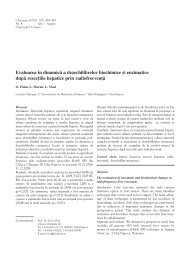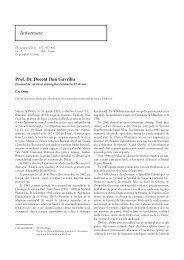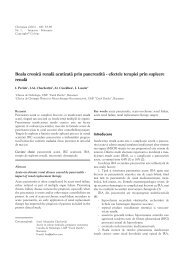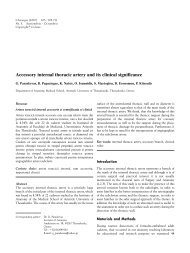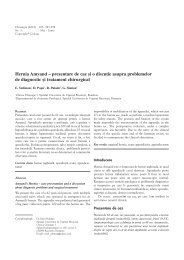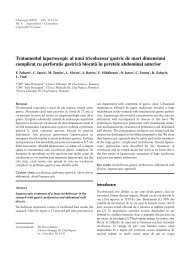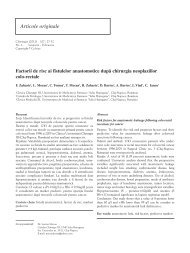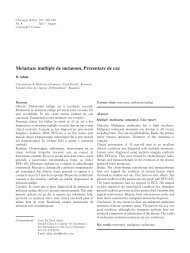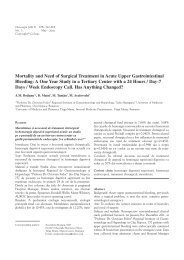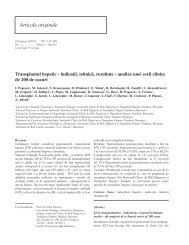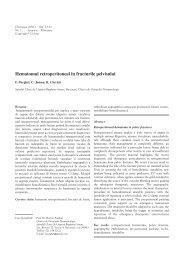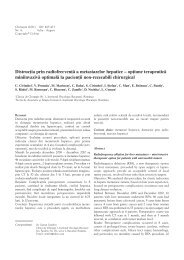Original Articles - Chirurgia
Original Articles - Chirurgia
Original Articles - Chirurgia
You also want an ePaper? Increase the reach of your titles
YUMPU automatically turns print PDFs into web optimized ePapers that Google loves.
<strong>Original</strong> <strong>Articles</strong><br />
<strong>Chirurgia</strong> (2013) 108: 299-303<br />
No. 3,<br />
May - June<br />
Copyright© Celsius<br />
Single Centre Experience with Surgical Treatment of Hilar<br />
Cholangiocarcinoma<br />
N. Vladov 1 , Ts. Lukanova 1 , I. Takorov 1 , V. Mutafchiyski 1 , I. Vasilevski 1 , S. Sergeev 1 , E. Odisseeva 2<br />
1<br />
Department of Hepato-Biliary Surgery and Transplantation, Military Medical Hospital, Sofia, Bulgaria<br />
2<br />
Department of Anesthesiology and Intensive care, Military Medical Academy, Sofia, Bulgaria<br />
Rezumat<br />
Experienåa unui centru în tratamentul chirurgical al<br />
colangiocarcinomului hilar<br />
Premize/Scopuri: Rezecåia chirurgicalã este opåiunea terapeuticã<br />
radicalã pentru colangiocarcinoamele hilare. Cu toate acestea<br />
tratamentul curativ este dificil æi prognosticul pacienåilor este<br />
prost. O evaluare a opåiunilor chirurgicale æi a rezultatelor<br />
poate decela tratamentele eficiente.<br />
Material æi metodã: Am examinat retrospectiv caracteristicile<br />
demografice, protocoalele chirurgicale æi rezultatele la 64 de<br />
pacienåi cu colangiocarcinom hilar operaåi radical sau paliativ<br />
în perioada 2004-2012.<br />
Rezultate: Pacienåii au fost 43 de bãrbaåi æi 17 femei cu o vârstã<br />
medie de 61,4±10,4 ani (±SD, între 35-81 ani). Au fost<br />
efectuate 44 de rezecåii: R0 – 22 cazuri (34,4%), R1 – 10 cazuri<br />
(15,6%), R2 – 12 cazuri (18,7%) æi 20 operaåii paliative (31,3%).<br />
Rezecåie R0 a cãii biliare principale cu hepatectomie dreaptã<br />
extinsã la segmentul 1 a fost realizatã în 8 cazuri, rezecåia<br />
ductului hepatic comun cu hepatectomie stângã cu segment 1<br />
în 9 cazuri æi rezectia ductului hepatic comun în 5 cazuri.<br />
Procentul total de morbiditate postoperatorie este 51,5%.<br />
Complicaåiile au fost urmãtoarele: hemoragie intraabdominalã<br />
31,25%, fistula biliarã temporarã 26,56%, fistula anastomozei<br />
hepaticojejunale 7,81%, fistula biliarã 7,81%, insuficienåa<br />
Corresponding author:<br />
Nikola Vladov, MD<br />
Department of Hepato-Biliary Surgery and<br />
Transplantation, Military Medical Hospital<br />
3, GeorgiSofiiskyStr, 1606 Sofia, Bulgaria<br />
Tel: +359889290736<br />
E-mail: nvladov@yahoo.com<br />
hepaticã 17,18%, pleurezia 48,13%, abces intraabdominal<br />
28,13%, infecåia de plagã 48,3%. Supravieåuirea medie<br />
generalã la 5 ani pentru rezecåiile R0 este 32%, pentru<br />
rezecåiile R1 æi R2 de 12%, iar pentru operaåiile paliative 0%.<br />
Supravieåuirea medie generalã pentru rezecåiile R0 este de 37<br />
de luni, pentru rezecåiile R1 æi R2 este de 19 luni, iar pentru<br />
operaåiile paliative de 7 luni.<br />
Concluzie: Rezecåia chirurgicalã extinsã radicalã pentru<br />
colangiocarcinom hilar este necesarã pentru a obåine o<br />
supravieåuire mai lungã a pacientului.<br />
Cuvinte cheie: colangiocarcinom hilar, rezecåie chirurgicalã,<br />
hepatectomie extinsã<br />
Abstract<br />
Background/Aims: Surgical resection is a radical treatment<br />
option for hilar cholangiocarcinomas. However it is still<br />
difficult to cure and patient prognosis is poor. An evaluation<br />
of the surgical options and results may elucidate effective<br />
treatments.<br />
Methodology: We retrospectively examined the demographic<br />
characteristics, surgical records and outcome in 64 patients<br />
with hilar cholangiocarcinoma undergoing surgical resections<br />
or palliative surgical procedures for the period of 2004-2012.<br />
Results: The patients included 43 males and 17 females with a<br />
mean age of 61.4 ± 10.4 years (±SD, range 35-81 years). Fortyfour<br />
resections were done - R0 – 22 cases (34.4%), R1 – 10 (15.6<br />
%) cases, R2 – 12 cases (18.7%) and 20 palliative (31.3%)<br />
operations were performed. R0 - resection of common bile ducts<br />
with right hepatectomy with Sg 1 was done in 8 cases,<br />
resection of common hepatic duct with left hepatectomy with<br />
Sg 1 – in 9 cases and resection of common hepatic duct – in 5
300<br />
cases. The total percentage of postoperative morbidity is 51.5<br />
%. The types of complications are as follows: intra abdominal<br />
bleeding – 31.25 %, temporary biliary leakage - 26.56 %, leakage<br />
of hepatico-jejunostomy– 7.81 %, biliary fistula – 7.81%,<br />
liver insufficiency – 17.18 %, pleural effusion – 48.13 %, intraabdominal<br />
abscess – 28.13 %, surgical site infection – 48.3 %.<br />
The mean five-year overall survival for R0 - resection is 32%, for<br />
R1 - and R2 - resection is 12% and for the palliative operations<br />
- 0%. The mean overall survival for R0-resection is 37 months,<br />
for R1 - and R2 - resection is 19 months and for the palliative<br />
operations – 7 months.<br />
Conclusions: Radically extended surgical resection for hilar<br />
cholangiocarcinoma is necessary to obtain improved patient<br />
survival.<br />
Key words: hilar cholangiocarcinoma, surgical resection,<br />
extended hepatectomy<br />
Introduction<br />
Hilar cholangiocarcinomas are rare malignant tumors with a<br />
broad spectrum of treatment possibilities. They are known<br />
for their low percentage of resectability, high perioperative<br />
morbidity and mortality, as well as poor prognosis that<br />
makes surgical treatment still a challenge.<br />
The first resection of extrahepatic biliary ducts for<br />
carcinoma was carried out by Brown in 1954. In 1965 Klatskin<br />
published 13 cases describing the clinical and pathological<br />
characteristics of this disease and since then hilar cholangiocarcinomas<br />
are known as tumors of Klatskin. The first surgical<br />
series with a satisfactory survival but accompanied with high<br />
postoperative mortality and morbidity are published in 1970-ies<br />
(1, 3). Tumor resection remains challenging because of the close<br />
location to major vascular structures and the liver parenchyma.<br />
To estimate the present status regarding surgical<br />
treatment for hilar cholangiocarcinomas at our institute, we<br />
examined our series of hilar cholangiocarcinomas in 64<br />
consecutive patients and discussed the results, clinical<br />
significance and limitations. The results of the surgical<br />
treatment of hilar cholangiocarcinoma, carried out in a<br />
Hepato-Biliary Surgery and Transplantation Centre in<br />
Bulgaria are presented in this article.<br />
Patients and Methods<br />
In the Department of Hepato-Biliary Surgery and<br />
Transplantation, Military Medical Hospital, Sofia 64 patients<br />
with hilar cholangiocarcinoma underwent surgical resection<br />
between 2004 and 2012 and preoperative characteristics,<br />
surgical methods and postoperative outcomes are analysed in<br />
present study. The study design was approved by the human<br />
ethics review board at our institution. Informed consent for<br />
data collection was obtained from each patient during this<br />
period. A standard diagnostic imaging algorithm defining<br />
diagnosis and resectability of the tumor was strictly followed –<br />
ultrasonography, computer-tomography-angio-scan, magneticresonance<br />
imaging, endoscopic retrograde cholangiopancreatography.<br />
A resectional strategy according to the<br />
longitudinal growth of the tumor as described in Bismuth-<br />
Corlette classification (3) was followed.<br />
Operative procedures and follow-up<br />
Our surgical protocol strictly follows the well-known<br />
oncological standards of surgical treatment of hilar cholangiocarcinomas.<br />
The decision of whether right - or left<br />
hepatectomy is indicated is made according to the<br />
predominant site of the tumor lesion (taking into consideration<br />
longitudinal tumor extension). A radical R0-resection of<br />
biliary ducts and liver is carried out only if at least 30% of<br />
well-functioning residual liver parenchyma is guaranteed.<br />
Clear margins no less than 1 cm on proximal and distal<br />
biliary tract confirmed by frozen section should be achieved<br />
and resection of liver segment 1 – either isolated or associated<br />
with extended hepatectomy is done. Minimal volume of<br />
lymph node dissection is that of the hepatoduodenal ligament,<br />
posterior to the upper portion of the pancreatic head and<br />
around the common hepatic artery. ““No-touch” surgical<br />
technique is applied in order to prevent tumor spillage, biliary<br />
contamination of surgical field in order to prevent infection or<br />
tumor spreading and if not indicated, intraoperative tumor<br />
biopsy is not performed. Resection of common hepatic duct is<br />
selected only in patients with type I hilar cholangiocarcinoma<br />
without any evidence of liver parenchyma infiltration or<br />
lymphnode metastases in the hepatoduodenal ligament.<br />
Resection of common bile ducts with right hemihepatectomy<br />
with Sg 1 was performed in patients with type II a cancer,<br />
resection of common hepatic duct with left hemihepatectomy<br />
with Sg 1 was performed in patients with type IIb cancer. In<br />
cases of contralateral portal vein involvement, combined<br />
vascular resection was carried on.<br />
Statistical analysis program SPSS v14.0 was used for<br />
statistical analysis. Fisher-exact test and p-values were<br />
significant when lower than 0.05.<br />
Results<br />
The patients included were 43 males and 17 females with a<br />
mean age of 61.4 ± 10.4 years (±SD, range 35-81 years).<br />
Preoperatively 84% of patients received biliary drainage –<br />
the proportion between endoscopically placing an endoprothesis<br />
and percutaneous biliary drainage was 4:1.<br />
Forty-four resections were done - R0 – 22 cases (34.4%),<br />
R1 – 10 (15.6 %) cases, R2 – 12 cases (18.7%) and 20<br />
palliative (31.3%) operations were performed. Three cases of<br />
R0-resections were accompanied with a resection of the<br />
contralateral portal branch. Resection of common bile ducts<br />
with right hepatectomy with Sg 1 was done in 8 cases<br />
(Fig. 1A), resection of common hepatic duct with left<br />
hepatectomy with Sg 1 – in 9 cases (Fig. 1B) and resection<br />
of common hepatic duct – in 5 cases. (Fig. 1)
301<br />
A<br />
B<br />
Figure 1.<br />
(A) Extended right hepatectomy + Sg1 in a hilar cholangiocarcinoma type III a; (B) Extended left hepatectomy + Sg1 for hilar<br />
cholangiocarcinoma type III b<br />
The total percentage of postoperative morbidity is 51.5 %.<br />
The types of complications are as follows: intraabdominal<br />
bleeding – 31.25 %, temporary biliary leakage - 26.56 %, leakage<br />
of hepatico-jejunoanastomosis – 7.81 %, biliary fistula –<br />
7.81%, liver insufficiency – 17.18 %, pleural effusion – 48.13<br />
%, intraabdominal abscess – 28.13 %, surgical site infection –<br />
48.3 %.<br />
Complication rate for patients with preoperative biliary<br />
drainage is slightly higher – 55.6 % to 47.4 % without<br />
statistically remarkable significance (p=0.634).<br />
The perioperative mortality of the series discussed is 7.8<br />
% (5 cases).<br />
Tumor stage was T1 in 4 patients (6.25%), T2 in 12<br />
(18.75%), T3 in 16 (25%) and T4 in 32 patients (50%).<br />
The mean and five-year overall survival rates are<br />
presented in Table 1. The mean five-year overall survival for<br />
R0-resection is 32%, for R1- and R2-resection is 12% and<br />
for the palliative operations - 0%. The mean overall survival<br />
for R0-resection is 37 months, for R1- and R2-resection is 19<br />
months and for the palliative operations – 7 months<br />
(p
302<br />
treatment of patients with obstructive jaundice and hilar<br />
cholangiocarcinoma is still controversial. Its routine use in<br />
patients with obstructive jaundice and namely those with<br />
carcinoma of the distal biliary ducts without actual complications<br />
is not recommended, having in mind reports of negative<br />
effects such as acute pancreatitis, cholangitis, as well as tumor<br />
dissemination along the interventional route and a metaanalysis<br />
comparing both operative interventions, concluding<br />
lack of advantages of this intervention (21).<br />
Our results denote increased rate of perioperative<br />
complications although not statistically significant. Leading<br />
cause of shortcoming is surgical infection. Our opinion is that<br />
if radical surgical treatment is intended at an early diagnosed<br />
hilar carcinoma an uncomplicated field of operation should be<br />
essential if not mandatory and invasive cholangiography should<br />
be reserved for therapeutic decompression where there is<br />
cholangitis or stent insertion in unresectable cases.<br />
Despite the achievements in hilar carcinoma treatment<br />
there are still controversial issues to be discussed. These<br />
include – the type and the volume of the resection, the<br />
resection of caudate lobe and portal vein as well as the need<br />
and volume of lymph node dissection.<br />
The surgical protocol strictly observed at our clinic<br />
follows the well-known standards of surgical treatment of hilar<br />
cholangiocarcinomas and most cases follow the resectional<br />
strategy described in Bismuth-Corlette classification (3,4,5,<br />
14,15): types I and II can be resected with excision of the<br />
extrahepatic bile duct with or without the hilar plate and<br />
caudate lobe, types IIIA and IIIB can be resected with the<br />
addition of an “en bloc” right or left hepatic hepatectomy,<br />
respectively and type IV is by definition unresectable and the<br />
most applied method in this case is percutaneous biliary<br />
drainage. The most economical alternatives are the local or<br />
hilar resections of the extrahepatic biliary ducts. Our results<br />
show the importance of partial hepatectomy in achieving a<br />
complete resection and further suggest that only a concomitant<br />
hepatic resection effectively clears all disease and offers<br />
the possibility of prolonged survival.<br />
Major liver resections for hilar cholangiocarcinomas are<br />
potentially accompanied by developing liver failure as<br />
described in up to 32 % of patients with combined<br />
resections (11) as well as increased risk of postoperative<br />
complications (15,16,17). In this concern portal vein<br />
embolisation is a strategy of inducing hypertrophy in the<br />
anticipated remaining hepatic remnant for prevention of<br />
liver failure (19, 20). The effectiveness and safeness of this<br />
procedure have been proved and it should be discussed in<br />
patients with anticipated liver remnant volume of under 20<br />
% from the total one (20).<br />
Although there are no prospective randomized trials<br />
comparing the results between common bile duct resection to<br />
major hepatic and biliary resections some retrospective studies<br />
point out advantages in resection margins and increasing the<br />
overall survival in major interventions despite higher<br />
percentage of overall morbidity and mortality (11). The major<br />
sources of morbidity remain infectious complications and<br />
biliary complications (anastomotic or hepatic parenchymal<br />
leak), with mortality rates generally around or slightly less than<br />
10% (23). The complication rate in major hepatic resections<br />
seems to have decreased considerably in recent years<br />
(12,13,17). Our complication rate is still high but there is a<br />
tendency of a steady decrease over the past years along with<br />
increasing the relative volume of major hepatic resections at<br />
our center carried out both for primary and secondary biliary<br />
and hepatic malignancies, as well as with better preoperative<br />
selection and improved anesthesiological and intensive care.<br />
We advocate the statement that nowadays extended right - or<br />
left hepatectomy are to be regarded as standard radical<br />
operation for hilarcholangiocarcinoma.<br />
One of the major problems of hilar cholangiocarcinoma<br />
resection technique is the development of local recurrence.<br />
Many studies reveal caudate lobe involvement and it being the<br />
main liver recurrence location (8,11). Some authors recommend<br />
routine resection of the caudate lobe in order to decrease<br />
its incidence (14). If the hepatic duct confluence is involved,<br />
we resect the first liver segment whatever hepatic procedure is<br />
planned. The reason for this is the high incidence of bile duct<br />
involvement as the tumor spread follows three main routes –<br />
infiltration along the bile duct epithelium, direct infiltration<br />
of the first liver segment parenchyma, periductal infiltration of<br />
the interstitium of the lobus caudatus (9,18). The caudate lobe<br />
and the connecting liver parenchyma are usually localized<br />
behind the biliary duct and portal bifurcation. There are many<br />
tiny biliary ducts draining towards the main biliary tree in<br />
vicinity to its bifurcation (9). The caudate lobe resection<br />
recommenders point out the fact that this improves the<br />
margin status at a minimally increased complication rate<br />
optional by other authors, when there is suggested tumor<br />
extension into the caudate lobe (2,14,15). Nowadays all<br />
liver resections for hilar cholangiocarcinoma should be<br />
accompanied by caudate lobe resection (14).<br />
The portal vein resection and reconstruction is considered a<br />
routine procedure that is to be conducted in highly specialized<br />
centers. It is to be performed only in selected patients if venous<br />
infiltration is detected preoperatively or intraoperatively during<br />
the course of the operation (13,22). Our experience is limited to<br />
three cases with portal resection for surgical treatment of hilar<br />
cholangiocarcinoma without increasing the rate of postoperative<br />
complications (p=0.761).<br />
Numerous clinico-pathological factors have been proven<br />
to have positive effects on the long-term survival such as<br />
negative surgical margins, liver resection done, negative<br />
nodal status, lower T-status, well differentiated tumor, lack of<br />
perineural invasion (6,7,12,18). Despite the achievements in<br />
the surgical treatment of hilarcholangiocarcinomas the fiveyear<br />
survival varies from 25%to 40% in recently published<br />
series. In our series aggressive surgical resection was<br />
performed in 44 patients with hilar cholangiocarcinoma<br />
over the past 8 years and radical operations were safely<br />
performed in many cases. While palliative operations<br />
showed no survival at 5 years, R0 and R1-2 resections’<br />
survival proves the efficacy of extended surgical resection.
303<br />
Conclusion<br />
Radical surgical treatment performed by a highly specialized<br />
team in a high volume hepato-biliary centre remains the<br />
most effective and the only potentially curative treatment of<br />
hilar cholangiocarcinomas. The modern surgical tactics<br />
requires “en bloc” resection of extrahepatic biliary duct and<br />
unilateral hepatic lobe extended in most cases to Sg1. Clear<br />
margins and adequate sufficient function of the liver<br />
remnant along with assured biliary drainage are prerequisites<br />
of acquiring a long-term good survival.<br />
References<br />
1. Klatskin G. Adenocarcinoma of the hepatic duct at its<br />
bifurcation within the porta hepatis. An unusual tumor with<br />
distinctive clinical and pathological features. Am J Med. 1965;<br />
38:241-56.<br />
2. Dinant S, Gerhards MF, Rauws EA, Busch OR, Gouma DJ,<br />
van Gulik TM. Improved outcome of resection of hilar<br />
cholangiocarcinoma (Klatskin tumor). Ann Surg Oncol. 2006;<br />
13(6):872-80. Epub 2006 Apr 14.<br />
3. Bismuth H, Corlette M. Intrahepatic cholangioenteric anastomosis<br />
in carcinoma of the hilus of the liver. Surg Gynecol<br />
Obstet. 1975;140(2):170-8.<br />
4. Nakeeb A, Pitt HA, Sohn TA, Coleman J, Abrams RA,<br />
Piantadosi S, et al. Cholangiocarcinoma. A spectrum of intrahepatic,<br />
perihilar, and distal tumors. Ann Surg. 1996;224(4):<br />
463-73; discussion 473-5.<br />
5. Bismuth H, Nakache R, Diamond T. Management strategies<br />
in resection for hilarcholangiocarcinoma. Ann Surg. 1992;<br />
215(1):31-8.<br />
6. Klempnauer J, Ridder GJ, von Wasielewski R, Werner M,<br />
Weimann A, Pichlmayr R. Resectional surgery of hilar cholangiocarcinoma:<br />
a multivariate analysis of prognostic factors. J Clin<br />
Oncol. 1997;15(3):947-54.<br />
7. Ito K, Ito H, Allen PJ, Gonen M, Klimstra D, D'Angelica MI,<br />
et al. Adequate lymph node assessment for extrahepatic bile<br />
duct adenocarcinoma. Ann Surg. 2010;251(4):675-81.<br />
8. Neuhaus P, Thelen A. Radical surgery for right-sided Klatskin<br />
tumor. HPB (Oxford). 2008;10(3):171-3.<br />
9. Abdalla EK, Vauthey J, Couinaud C. The caudate lobe of the<br />
liver: implications of embryology and anatomy for surgery.<br />
Surg Oncol Clin N Am. 2002;11(4):835-48.<br />
10. Jarnagin W, Winston C. Hilar cholangiocarcinoma: diagnosis<br />
and staging. HPB (Oxford). 2005;7(4):244-51.<br />
11. Miyazaki M, Ito H, Nakagawa K, Ambiru S, Shimizu H,<br />
Shimizu Y, et al. Aggressive surgical approaches to hilar<br />
cholangiocarcinoma: hepatic or local resection Surgery. 1998;<br />
123(2):131-6.<br />
12. Baton O, Azoulay D, Adam DV, Castaing D. Major hepatectomy<br />
for hilarcholangiocarcinoma type 3 and 4: prognostic factors and<br />
long term outcomes. J Am Coll Surg. 2007;204(2):250-60. Epub<br />
2006 Dec 27.<br />
13. Nimura Y, Kamiya J, Kondo S, Nagino M, Uesaka K, Oda K,<br />
et al. Aggressive preoperative management and extended<br />
surgery for hilarcholangiocarcinoma: Nagoya experience. J<br />
Hepatobiliary Pancreat Surg. 2000;7(2):155-62.<br />
14. Khan SA, Davidson BR, Goldin R, Pereira SP, Rosenberg<br />
WM, Taylor-Robinson SD, et al. Guidelines for the diagnosis<br />
and treatment of cholangiocarcinoma: consensus document.<br />
Gut. 2002;51 Suppl 6:VI1-9.<br />
15. Hemming AW, Reed AI, Fujita S, Foley DP, Howard RJ.<br />
Surgical management of hilar cholangiocarcinoma. Ann Surg.<br />
2005;241(5):693-9; discussion 699-702.<br />
16. Nimura Y. Radical surgery of left-sided Klatskin tumors. HPB<br />
(Oxford). 2008;10(3):168-70.<br />
17. Washburn W, Lewis W, Jenkins R. Aggressive surgical resection<br />
for cholangiocarcinoma. Arch Surg. 1995;130(3):270-6.<br />
18. Burke EC, Jarnagin WR, Hochwald SN, Pisters PW, Fong Y,<br />
Blumgart LH. Hilar cholangiocarcinoma: patterns of spread,<br />
the importance of hepatic resection for curative operation,<br />
and a presurgical clinical staging system. Ann Surg. 1998;<br />
228(3):385-94.<br />
19. Jarnagin WR, Fong Y, DeMatteo RP, Gonen M, Burke EC,<br />
Bodniewicz BS J, et al. Staging, resectability, and outcome in<br />
225 patients with hilar cholangiocarcinoma. Ann Surg. 2001;<br />
234(4):507-17; discussion 517-9.<br />
20. Ebata T, Nagino M, Kamiya J, Uesaka K, Nagasaka T, Nimura Y.<br />
Hepatectomy with portal vein resection for hilar cholangiocarcinoma:<br />
audit of 52 consecutive cases. Ann Surg. 2003;<br />
238(5):720-7.<br />
21. Sewnath ME, Karsten TM, Prins MH, Rauws EJ, Obertop H,<br />
Gouma DJ. A meta-analysis on the efficacy of preoperative<br />
biliary drainage for tumours causing obstructive jaundice. Ann<br />
Surg. 2002;236(1):17-27.<br />
22. Nagino M, Nimura Y. Perihilar cholangiocarcinoma with<br />
emphasis on presurgical management. In: Blumgart LH (ed).<br />
Surgery of the liver, biliary tract, and pancreas. 4th edn.<br />
Philadelphia: Saunders Elsevier; 2006. p. 804–814.<br />
23. Hasegawa S, Ikai I, Fujii H, Hatano E, Shimahara Y. Surgical<br />
resection of hilarcholangiocarcinoma: analysis of survival<br />
and postoperative complications. World J Surg. 2007;31(6):<br />
1256-63.


